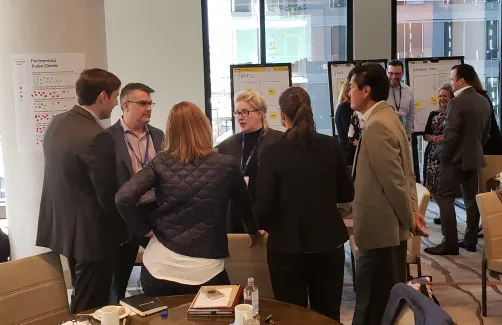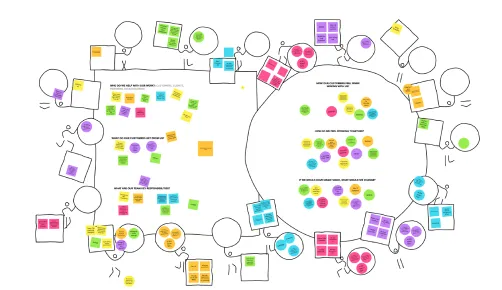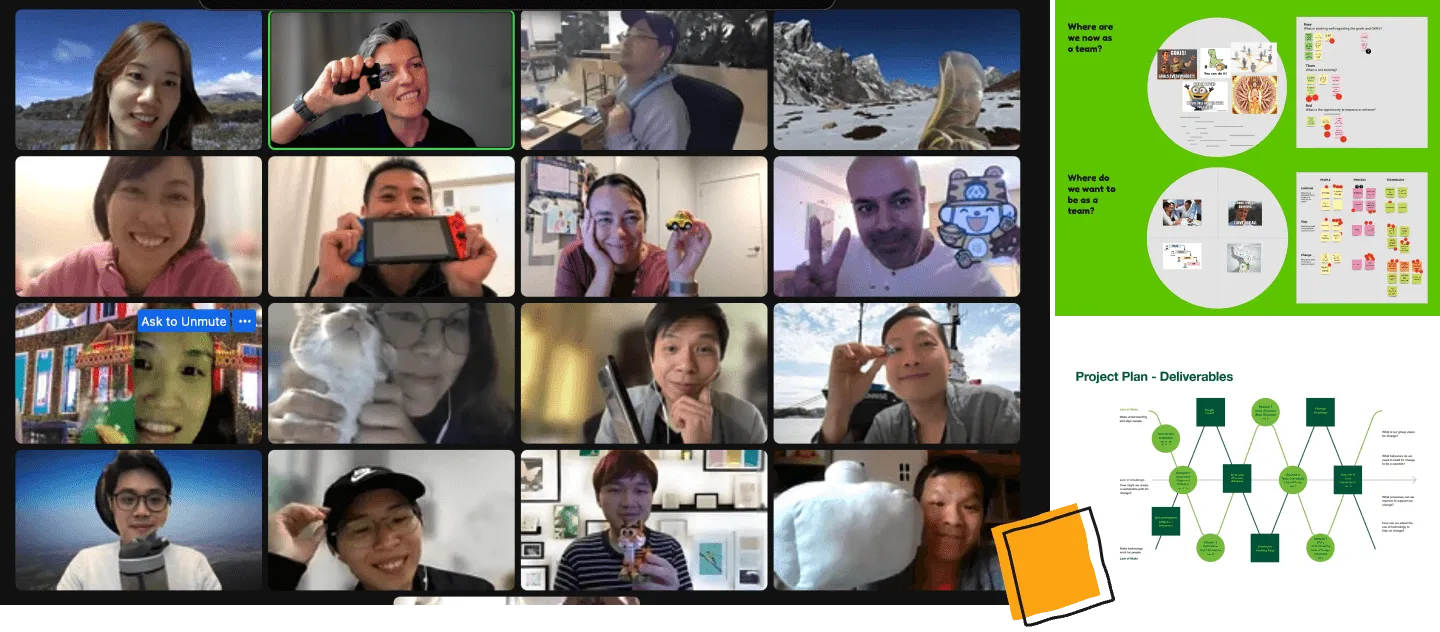Facilitated People, Process, And Technology Alignment for Greenpeace East Asia
How did we break down team silos across the organization and help its leaders develop a positive leadership mindset in just six sessions?
USE CASE
Change Management
Digital Transformation
Team Alignment
DELIVERY
Online
RESULTS
Break down silos
Clarity and prioritization
Mindset and behavior change
CLIENT

Greenpeace has been in East Asia since 1997 to fight climate change, stop toxic pollution, ensure food security, end illegal deforestation and defend the oceans.
Background
Greenpeace East Asia is the East Asian regional branch of Greenpeace—a global non-governmental environmental organization that draws attention to significant environmental threats, with non-violent direct action, and lobbies for solutions. It is located in China and is one of the largest international NGOs in the country.
The organization had recently invested in technology upgrades and added additional headcount, in a bid to transform their work processes. However, the organisation’s leadership was facing challenges with driving the transformation as quickly and effectively as they desired.
To help address the situation, we were approached and brought on board by the organisation’s Deputy Executive Director and leader of its transformation initiative, Cristina San Vicente.
Challenge
In a meeting we held with Cristina, we learned that she was doing a lot of heavy lifting in trying to make Greenpeace East Asia's digital transformation successful, but was getting a bit stuck due to several collaborative and integration issues. The organisation needed an effective technology stack and more workers skilled in operating and managing them.
Additionally, Greenpeace East Asia needed to develop more workflows to make the integration of its planned digital transformation quicker, seamless, and productive. The organisation’s teams and managers also needed to change their mindset and behaviour toward the new ways of working together.
Approach
We executed the project in partnership with Generate_Impact—a digital tech company that provides digital solutions to support humanitarian organisations. After assessing their situation, we concluded that Greenpeace East Asia needed an unconventional approach to solving its digital transformation challenges.
Our approach was to analyse the challenges they were facing from the inside out, which can be likened to looking through the other end of a telescope. Using this approach, we learned that Greenpeace East Asia’s main challenge was not about optimising its technology stack, but rather about aligning the work mindset and behaviour of its leaders and teams to make the optimisation they needed possible.
Usually, organisations and businesses seeking digital transformation often conduct the process based on the capabilities of the new solutions they were considering. However, we decided to base the digital transformation of Greenpeace East Asia on how it would affect its leaders and teams, individually and collectively, then figure out the best ways they could adapt and collaborate after the transformation.
More specifically, this meant understanding what mindset and behaviour the leaders and teams needed to change, both individually and collectively, to enable them adapt quickly and effectively to the changes the transformation the new technological solutions would bring. So, indeed, it is like looking at the situation from the other end of the telescope.
In order to carry out our plan, we needed to first enable shared ownership of the transformation process across the board. This meant breaking down teams' silos and transferring the leadership and planning from just the top leaders in the organization to all the stakeholders, and translating their ideas and visions into actionable outputs.
We then strategically designed facilitated sessions where everyone collaborated and contributed their ideas and vision for the organisation’s transformation and we translating them into actionable outputs. We worked with five teams on the project across four markets and six timezones, so all the collaboration was done online.
Conclusively, our unconventional approach allowed us to get to the root of their challenges quicker and more efficiently unlike traditional consulting. Our strategic facilitation of virtual collaboration among the teams, levelled the playing field by enabling inclusivity and collective intelligence for co-creating the solutions needed.
Process
We used the WakeMake Framework to plan the project ahead of time with Cristina and her team. The planning took two months and was done via six facilitated online co-creation sessions, where we planned out everything from the stakeholder engagement process to the scope of the project, and the project execution process.
After planning, we kickstarted the project and it took about three months altogether, from start to finish. Just like the planning, the execution of the project was also done virtually, and we worked with five teams on the project, across four markets and six timezones.
The entire project was carried out in four phases:
Phase One
Analysing the situation through 1-on-1 stakeholder interviews and studying existing documentation, then turning interview findings into an insight report.
Phase Two
Aligning the perspectives of the organisation’s leadership towards a collective vision for overcoming its digital transformation challenges.
Phase Three
Enabling shared ownership of the organisation’s digital transformation plans among both the leaders and teams.
Phase Four
Collectively planning for possible obstacles to the project, outcomes to expect, sorting priorities on best actions to take, and developing a roadmap for the digital transformation.
Results
There was a positive change in behaviour of the leaders and teams towards their respective roles and the organisation’s transformation plans. According to Cristina, the organisation’s Deputy Executive Director, these changes were what she had been trying to make in the organization for years.
Cristina said, "I immediately saw critical changes in behaviour. In a short time, I've seen the co-creation of projects I was trying to achieve for years to break down the silos. Now I see ten people get together and decide to do a KPI strategy by themselves."
Speaking more on how productive the project was for her and team, Cristina said, "People kept saying I'm not the one building the technology, therefore I couldn’t have a say in how it defines the way I work. Besides hierarchy, we had silos around expertise, ownership, and accountability. The process we went through leveled that out."
Also sharing similar feedback was Rebecca Scelly, a project manager from Greenpeace. She said, "Immediately after experienced WakeMake’s sessions, people started changing their behaviours.”
Commenting further, Rebecca said, “before, people were reluctant to step out of their job role and reach out to team members in different markets or get involved in conversations they could participate in. Now, they engage each other more and speak out when they feel they have something valuable to contribute."
Giving Clarity and Direction
Business transformations are often very complex and come with various challenges. For most people experiencing a business transformation for the first time, as the challenges start to show, it can be quite difficult for them to choose which one to tackle first. This issue was one of the things we ensured we addressed with this project and we were successful.
One of the feedback we got from most participants was about how they received clarity and direction on how to prioritise and tackle challenges based on their level of complexity. They also testified about learning how to prioritise challenges as they come and know the right approach to tackle them without disrupting their workflow.
We were able to achieve this through the interviews and co-creation sessions we facilitated for the organization. Our team analysed the insights we got about their situation and helped them understand what they meant, to enable them better prioritise and tackle any challenge that they may experience at any point during the transformation process.
According to the feedback we got from Cristina, our approach helped her learn more about prioritisation as a leader. She said, "Most of the insights were not surprising. I had a good sense of what was going on, but I wasn't in a position or had the expertise to prioritise. As a leader, I don't have all the answers. The team does. So the question was how to get the team to prioritise together. Iva and her team facilitated that process.”
Cultivating a positive leadership mindset
Another significant result the project produced was helping the leaders cultivate a positive mindset in their leadership. Change is difficult for most people, but the change that comes with digital transformation is often more difficult and requires everyone on board to broaden their knowledge to learn and implement quick and effective ways of adapting.
Inability to adapt to the changes that come with organisational or business transformation can get quite overwhelming, especially for leaders. It often causes burnout and breeds a negative work mindset. People with a negative mindset tend to take less responsibility for their actions and would rather play blame games instead.
While working on this project, we discovered that many of the organisation’s leaders who had been working passionately on its transformation had become burned out and were also beginning to have a negative perspective on where the change was going. They had low expectations about the transformation, but we managed to change that.
We were able to help them develop a collective vision for the project, which we translated into a change roadmap. Everyone participated 100% and shared their ideas on how to change their mindset to enable them work better together and lead their teams towards making the transformation successful.
After a few radically inclusive and collaborative sessions we facilitated, we started getting comments like, "No one wants any more negativity," and "It is nice to see that others have the same problems." It was great to notice the mindset of the leaders changing positively.
Adoptions of additional ways of working
Aside from facilitating a positive change in the mindset of the organisation’s leaders, we also introduced them to additional ways of working. Some of them include working together through visual collaboration boards such as Miro, among several others. They tried out the tools we recommended and adopted them for regular use.
We also introduced them to the "Listening to learn” concept, which according to Cristina, was one of the most impactful takeaways from the project. She said, "one big takeaway that Iva inspired me throughout this process is listening to learn. As leaders, we either listen to win, try to win an argument at a particular time, or listen to fix. That's one of my Achilles heels. I'm always trying to provide solutions for my team to enable the transformation to move faster. But I wasn't listening to learn the barriers to why the team was struggling to transform our business. So taking that kind of step back allowed me to listen more."
Moving forward
With all the results achieved from this project, all the leaders and teams we worked with in the project with Greenpeace East Asia are now better equipped to tackle all the challenges that may come with the organisation’s digital transformation.
That being said, transforming an organization or business is an evolving process that takes time to fully manifest and won’t happen after just a few workshops. We communicated this to all the stakeholders as we rounded off the project, especially to Cristina, who was the leader in charge of driving the transformation.
Speaking about the continuity of the process, Cristina said: "You don't do this process, and suddenly the light switches. Through this project, we ended up with some of the core results. I learned a lot in changing my leadership; I think the team learned a lot. This will help us change over time and transform our business for a successful future."
We delivered a 60-page comprehensive report after the completion of the project, including 6 visual boards with the collective input that was made by all the participants. This would help with the further development of accountability of all the stakeholders and shared ownership of the organisation’s transformation.
WakeMake continues to work with Greenpeace East Asia to support the continuous development of the collaborative problem-solving skills of its leaders and teams, including the facilitation of its future critical strategic planning initiatives.


Co-Creation of an Operating Framework
How did we develop "buy-in" and a sense of ownership to co-create an operating framework for members of a diverse global professional association in a short time period?


Regional Team Alignment
How did we help regional team leader gain clarity and build new team shared understanding accross four brands and five markets in the mids of pandemic?
START THE CONVERSATION
Let's Talk
Send us a message about your situation or book a 15 minute-call for a one-on-one consultation with us to discuss your situation and answer any questions you may have.
We'll analyse the challenges you are facing and recommend quick and effective strategies you can implement to overcome them.


